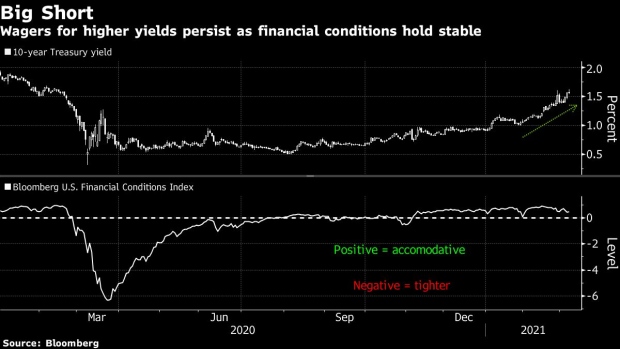Mar 6, 2021
Bond Traders Go All-In on U.S. Treasury Market’s Big Short Bet
, Bloomberg News

(Bloomberg) -- It’s not just in meme stocks that the fate of short sellers is a key theme. Short bets are increasingly in vogue in the $21 trillion Treasuries market, with crucial implications across asset classes.
The benchmark 10-year yield reached 1.62% Friday -- the highest since February 2020 -- before dip buying from foreign investors emerged. Stronger-than-expected job creation and Federal Reserve Chair Jerome Powell’s seeming lack of concern, for now, with leaping long-term borrowing costs have emboldened traders. In one telltale sign of which way they’re leaning, demand to borrow 10-year notes in the repurchase-agreement market is so great that rates have gone negative, likely part of a move to short the maturity.
The trifecta of more fiscal stimulus ahead, ultra-easy monetary policy and an accelerating vaccination campaign is helping bring a post-pandemic reality into view. There are of course risks to the bearish bond scenario. Most prominently, yields could rise to the point that they spook stocks, and tighten financial conditions generally -- a key metric the Fed is focused on for guiding policy. Even so, Wall Street analysts can’t seem to lift year-end yield forecasts fast enough.
“There’s a lot of tinder being put now on this fire for higher yields,” said Margaret Kerins, global head of fixed-income strategy at BMO Capital Markets. “The question is what is the point that higher yields are too high and really put pressure on risk assets and push Powell into action” to try and tamp them down.
Share prices have already shown signs of vulnerability to increasing yields, especially tech-heavy stocks. Another area at risk is the housing market -- a bright spot for the economy -- with mortgage rates jumping.
The surge in yields and growing confidence in the economic recovery prompted a slew of analysts to recalibrate expectations for 10-year rates this past week. For example, TD Securities and Societe Generale lifted their year-end forecasts to 2% from 1.45% and 1.50%, respectively.
Asset managers, for their part, flipped to most net short on 10-year notes since 2016, the latest Commodity Futures Trading Commission data show.
Auction Pressure
In the days ahead, however, BMO is eyeing 1.75% as the next key mark, a level last seen in January 2020, weeks before the pandemic sent markets into a chaotic frenzy.
A fresh dose of long-end supply next week may make short positions even more attractive, especially after record-low demand for last month’s 7-year auction served as a trigger to push 10-year yields above 1.6%. The Treasury will sell a total of $62 billion in 10- and 30-year debt.
With expectations for inflation and growth taking flight, traders are signaling that they anticipate the Fed may have to respond more quickly than it’s indicated. Eurodollar futures now reflect a quarter-point hike in the first quarter of 2023, but they’re starting to suggest that it could come in late 2022. Fed officials have projected they’d keep rates near zero until at least the end of 2023.
So while the market is leaning toward loftier yields, the interplay between bonds and stocks is bound to be a huge focus going forward.
“There’s definitely that momentum, but the question is how well risky assets adjust to the new paradigm,” said Subadra Rajappa, head of U.S. rates strategy at Societe Generale. “We’ll be watching next week, when the dust settles after the payrolls data, how Treasuries react and how risky assets react to the rise in yields.”
What to Watch
- The economic calendar
- March 8: Wholesale trade sales/inventories
- March 9: NFIB small business optimism
- March 10: MBA mortgage applications; CPI; average weekly earnings; monthly budget statement
- March 11: Jobless claims; Langer consumer comfort; JOLTS job openings: household change in net worth
- March 12: PPI; University of Michigan sentiment
- The Fed calendar is empty before the March 17 policy decision
- The auction calendar:
- March 8: 13-, 26-week bills
- March 9: 42-day cash-management bills; 3-year notes
- March 10: 10-year notes
- March 11: 4-, 8-week bills; 30-year bonds
©2021 Bloomberg L.P.


